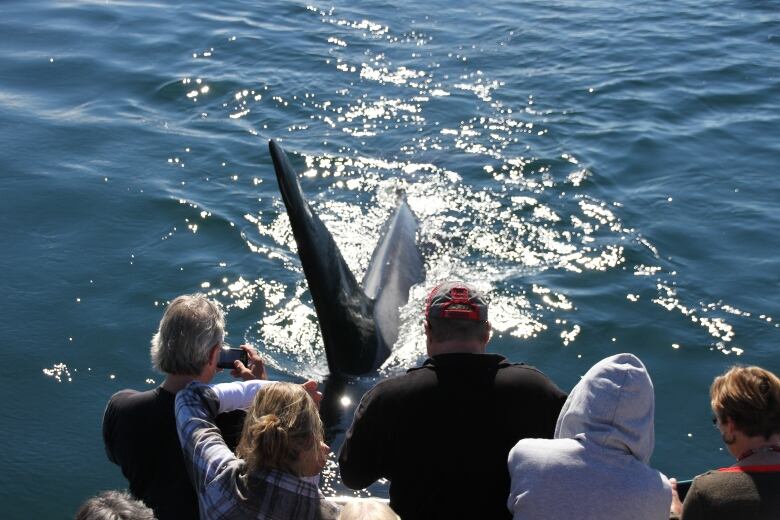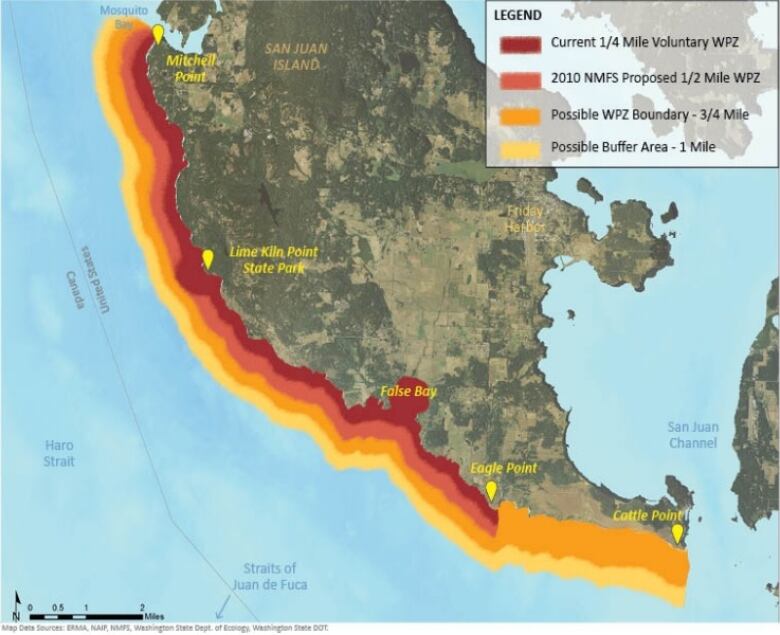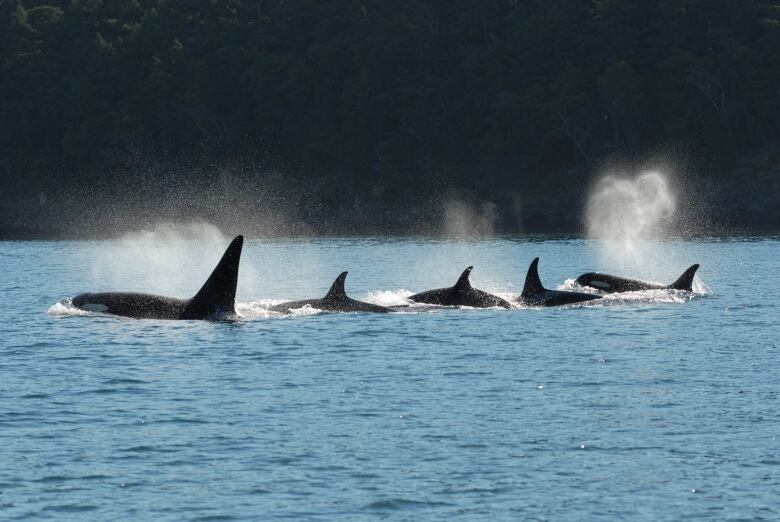U.S. conservation group proposes buffer zone to protect orcas
B.C. advocates describe proposed protected area as 'a bold move that needs to happen'

Killer whale advocates in British Columbia describea federal petition submitted in the U.S. to create a safe foraging zone for southern resident killer whales as"a bold move that needs to happen."
This week theOrcaRelief Citizens' Alliancefiled a federal petition that asks for theNational Oceanic and Atmospheric Administrationto create a 26-square-kilometre buffer zone in Washington State,along the western shore of San Juan Island in theSalishSea.
Vessels in the zone would be required to reduce their speed to the point where they create no wake, which would reduce underwater noisewhich disturbs orcas.
"This [non-government organization]in the U.S. has shown real leadership and that we need to follow suit in Canada," said Misty MacDuffee, a biologist with the Raincoast Conservation Foundation.
The area, which is in the Haro Strait, along the nautical Canada-U.S. border is frequented by about 80 killer whales that make up the endangered southern resident population.
"We understand that they may be very well on the brink of extinction and action has to happen now," said Scott West with the Orca Relief alliance.
The "whale protection zone" would extend 1,200 metres from the shore and create a quiet zone.
'Reduce noise, disturbance'
"The petition is focused on the critical need to reduce noise and disturbance of [orcas] in the centre of their critical habitat," reads the application.
Orcasrely on sound to hunt and communicate with one another, so the alliance hopes to create conditions that would allow them to do that better in the Salish Sea,which is known for boat traffic, including whale-watching companies.

"We don't think about the Salish Sea as being urban, right, because it's in the sea, but it's basically an urban area," said Dr. Jason Colby, a historian at the University of Victoria who studies humanrelationship to the iconic whales.
Colby who estimates there could have been up to 250 southern residents in the mid-1800ssays the buffer zone is a good idea, a small step that could help the animals who faceboat noise, a lack of food and toxins.
"It would be a tragedy to lose this population. I mean they've become part of the fabric of our culture in this region," he said. "It's almost impossible to imagine the region without them."
The petition comes after an iconic southern resident orca, J28, died after losing weight for months. It's assumed that her calf, J54, also perished because the mother could not nurse it.
J54 had been one of the whales born to what is described as a baby boom for the animals eight calves in 2015 which buoyed the population up to approximately 85 whales.But recentdeaths like J28 and her calf broughtthe number down to 80.
Unique diet, language, culture
"Up until fairly recently people didn't know the plight of these whales and, you know, it's really just been through science that we've understood how unique this population is in terms of its diet, its language and its culture," said MacDuffee.
The Raincoast Conservation Foundation recently published a viability analysis looking at pressures on the southern residentsthat found,"increased noise and vessel disturbance will intensify existing threats, giving them a slim chance of recovery."

But the study also determined that reducing noise and makingChinook salmon a staple of the orcas' diet more available would help reverse the population's' decline.
MacDuffee and others in Canada are applauding the U.S. petition, becausethey see the potential protection zone as a viable tool to help southern residents.
They also want Canadiansto lobby the federal government to takesimilar actionhere, while the Orca Relief Citizens' Alliance wants Canadians to support the U.S. buffer zoneby signing a public-opinion petition online that they've also filed about the protection zone.
The #SRKW #orca population is starving, breaching dams takes time, set up a #whale protection zone to give them a chance //ow.ly/FSbD305G8iw
—@OrcaRelief"Because NOAA needs to hear, not just U.S. citizens, but anybody on the planet that cares about these whales," said West. "NOAA needs to know that there is public support for taking swift andsure action."
Currently in Canada boaters who come upon whales mustslow to seven knots, stay 100 metres away, and limit viewing to 30 minutes in duration.














_(720p).jpg)


 OFFICIAL HD MUSIC VIDEO.jpg)
.jpg)



























































































